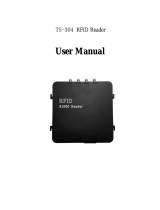
Before You Begin
x IF2 Network Reader User’s Manual
Patent Information
Product is covered by one or more of the following patents:
5,414,624; 5,479,160; 5,485,520, 5,504,485; 5,510,795; 5,521,601;
5,528,222; 5,538,803; 5,550,547; 5,552,778; 5,554,974; 5,563,583;
5,565,847; 5,606,322; 5,606,323; 5,635,693; 5,673,037; 5,680,106;
5,682,143; 5,729,201; 5,729,697; 5,736,929; 5,737,710; 5,739,754;
5,763,867; 5,767,789; 5,777,561; 5,786,626; 5,812,065; 5,821,859;
5,825,045; 5,826,328; 5,828,318; 5,828,693; 5,831,532; 5,850,181;
5,850,187; 5,874,902; 5,889,489; 5,909,176; 5,912,632; 5,939,984;
5,942,987; 5,962,837; 5,966,082; 5,972,156; 5,995,006; 5,995,019;
6,028,564; 6,032,127; 6,056,199; 6,078,251; 6,078,259; 6,097,347;
6,100,804; 6,104,281; 6,104,291; 6,109,526; 6,114,962; 6,118,379;
6,121,878; 6,121,880; 6,122,329; 6,130,612; 6,140,146; 6,147,604;
6,147,606; 6,163,260; 6,166,638; 6,172,596; 6,177,872; 6,195,053;
6,201,474; 6,204,765; 6,215,401; 6,215,402; 6,236,223; 6,239,703;
6,243,013; 6,246,326; 6,249,227; 6,259,408; 6,275,157; 6,278,413;
6,280,544; 6,281,794; 6,285,342; 6,286,762; 6,286,763; 6,288,629;
6,294,997; 6,294,998; 6,318,636; 6,320,509; 6,329,915; 6,357,662;
6,360,208; 6,366,260; 6,369,711; 6,371,375; 6,384,712; 6,400,274;
6,404,325; 6,412,086; 6,422,476; 6,429,775; 6,441,740; 6,486,769;
6,501,807; 6,518,885; 6,525,648; 6,529,880; 6,535,108; 6,535,175;
6,566,850; 6,593,845; 6,597,465; 6,608,551; 6,610,379; 6,639,509;
6,645,327; 6,677,852; 6,784,789; 6,794,000; 6,812,841; 6,812,852;
6,816,063; 6,830,181; 6,853,294; 6,859,190; 6,906,615; 6,919,793;
7,039,359; 7,075,413; 7,103,087; 7,121,467; 7,158,046; 7,190,257;
7,298,268; 7,447,251; 7,482,926; 7,486,172; 7,501,932; 7,541,929;
7,564,366; 7,616,094;
There may be other U.S. and foreign patents pending.























